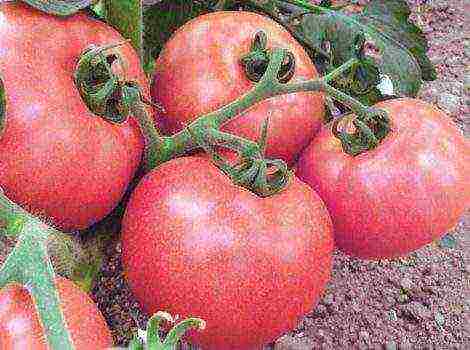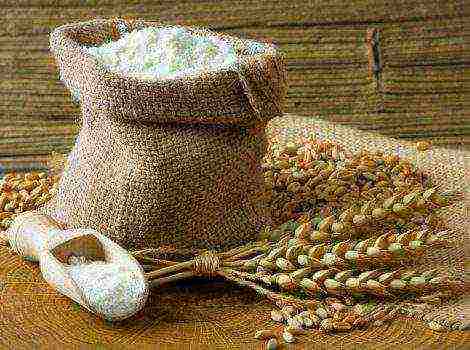Content [show]
Growing eggplants in Siberia - a few decades ago, this idea seemed impracticable. However, for many years in a row, gardeners in the cold region have been successfully harvesting these fresh nightshades. What varieties did Siberian summer residents like?
Eggplant is considered to be a heat-loving crop that evokes heat, southern sun and fertile soil. However, since the second half of the last century, "blue" are successfully grown in the middle lane and Siberia. Since these plants have a very long growing season (120-180 days), in the short Siberian summer, preference should be given to early and mid-early varieties. In the article, we tried to find the most productive, reliable and hardy varieties of delicious eggplants for Siberia.
White Night
Early maturing variety for open ground and film shelters. The plant is quite compact, 60-75 cm high. Fruits are white, elongated pear-shaped, up to 25 cm long. They keep their presentation well for a long time. Pulp without bitterness. Excellent taste makes it possible to use eggplants for canning, pickling and other types of culinary processing. The variety is resistant to tobacco and cucumber mosaic viruses, and is rarely affected by other eggplant diseases.
| Appointment | Productivity (kg / sq.m) | Fruit weight (g) | Maturation (days) | Pulp color |
| 5-7 | 200-300 | 105-115 | Snow white | |
Bibo F
This hybrid variety is a true "Siberian" because it is capable of setting fruits in extreme temperatures. Refers to early maturing. The plant is semi-spreading, low. Fruits of regular oval-conical shape, white with a grayish tinge, without glossy sheen. The pulp does not taste bitter and gives the eggplant an excellent taste. Resistance to fusarium and tobacco mosaic virus has been recorded. And the rest of the Bibo F1 variety is very hardy and healthy.
| Appointment | Productivity (kg / sq.m) | Fruit weight (g) | Maturation (days) | Pulp color |
| 4-6 | 300-400 | 95-105 | Whitish | |
Bourgeois
An early ripe high-yielding variety that pleases with fruits both residents of the southern and northern regions. The plant is powerful and large, semi-spreading, characterized by a long fruiting period. The fruits are very large (over 10 cm in diameter), dark purple with a low gloss, more like tomatoes than eggplants. The pulp, without bitterness, has an original taste. The bourgeois is not used to fighting diseases, so in order to grow healthy and large fruits, you will have to carefully study agricultural technology.
| Appointment | Productivity (kg / sq.m) | Fruit weight (g) | Maturation (days) | Pulp color |
| 4-6 | 400-500 | 105-110 | Greenish | |
Helios
Medium early variety with low (50-60 cm) stocky plants. Fruits are small, pear-shaped-cylindrical, violet-ink color. The "sunny" name of the variety predetermined its unique mushroom taste. Proteins, carbohydrates, mineral salts and other useful substances in fruits are in a very balanced state, therefore they are used for medical and dietary nutrition. The pulp is dense, without bitterness, with a sweetish taste. The variety is relatively resistant to various diseases.
| Appointment | Productivity (kg / sq.m) | Fruit weight (g) | Maturation (days) | Pulp color |
| 4,5-5,5 | 400-650 | 115-120 | Snow white | |
Clorinda F1
An early ripe hybrid of eggplant, which is characterized by a vigorous and vigorous plant (90-100 cm) with a pronounced stem and short branches. Eggplants of this variety can be grown on trellises and ropes in a greenhouse and greenhouse. The fruits are oval, brilliant black with a glossy sheen. The pulp is dense, practically without seeds, good presentation and without bitterness. Classic mushroom taste. The plant is very resistant to cold weather and tobacco mosaic virus.
| Appointment | Productivity (kg / sq.m) | Fruit weight (g) | Maturation (days) | Pulp color |
| 2,8-4 | 900-1 200 | 65-80 | Whitish | |
Maria
A high-yielding mid-season variety, the bushes of which, in Siberian conditions, can be grown in a greenhouse and under a film shelter. They grow up to about 70-75 cm. Fruits are smooth and even, dark purple in color. The pulp is dense without bitterness, it is recommended for all types of culinary processing. Resistance to diseases (tobacco and cucumber mosaics) is quite high, as well as to frost and temperature changes.
| Appointment | Productivity (kg / sq.m) | Fruit weight (g) | Maturation (days) | Pulp color |
| 5-7 | 200-225 | 120-130 | White | |
Sailor
The fruits of this variety are difficult to confuse with any others. The striped lilac-white color clearly distinguishes them from their "brothers". The plant is semi-stemmed, spreading, up to 75 cm high with a large number of oval-pear-shaped fruits. The pulp without bitterness is best suited for cooking caviar and other culinary dishes. These eggplants can be stored for quite a long time without losing their presentation. The resistance of the variety to verticillary wilt was noted.
| Appointment | Productivity (kg / sq.m) | Fruit weight (g) | Maturation (days) | Pulp color |
| 8-10 | 250-400 | 100-105 | Snow white | |
Pelican F1
The neat bushes and fruits of this variety have gained popularity among Siberian gardeners. The plant reaches a height of 60-70 cm. Fruits are saber-shaped, milky white, matte in color. The pulp is of medium density, tender and tasty, without bitterness, suitable for all types of culinary processing. The variety is resistant to disease. Its distinctive feature is the incredible beauty of bright violet flowers during the flowering period of the plant.
| Appointment | Productivity (kg / sq.m) | Fruit weight (g) | Maturation (days) | Pulp color |
| 2-3 | 180-200 | 115-120 | White with a yellowish tinge | |
Ping pong F1
This variety does not yield very large yields, but it has a number of other advantages. The bushes are semi-spreading, medium-leafy, 0.7-0.8 m high. Fruits are spherical, rather small (4-6 cm in diameter), during ripening they become white, with a slight gloss. The pulp is firm, giving the eggplant a spicy taste. The fruits are well stored and do not lose their consumer properties even after long-term storage. Plants are able to withstand the main diseases of nightshade crops.
| Appointment | Productivity (kg / sq.m) | Fruit weight (g) | Maturation (days) | Pulp color |
| 1-1,5 | 60-80 | 110-115 | Greenish white | |
Black brilliant
An early maturing variety, the bushes are suitable for growing under a film cover and in greenhouses. The plant is not tall (50-60 cm), semi-spreading. Fruits are large, cylindrical, with a black-purple tint and a bright glossy sheen. They are tied at almost any temperature and in all weather conditions. The pulp is tasty, firm and without bitterness. Cooking does not require soaking vegetables in water. The resistance of the variety to diseases is average.
| Appointment | Productivity (kg / sq.m) | Fruit weight (g) | Maturation (days) | Pulp color |
| 5-6 | 200-250 | 105-110 | Milky white | |
Czech early
An early ripe high-yielding variety. The plant is stocky (50-60 cm), vigorous and tall. The fruit is ovoid, shiny and smooth, dark purple in color. The pulp is firm, without bitterness. Suitable for all types of cooking and home cooking. The resistance of the variety to diseases is average, as well as to temperature changes.
| Appointment | Productivity (kg / sq.m) | Fruit weight (g) | Maturation (days) | Pulp color |
| 4-5 | 300-500 | 100-110 | Greenish white | |
Nutcracker F
This variety with a "fabulous" name refers to mid-early high-yielding hybrids. The bushes are sprawling and rather tall - up to 80 cm. Fruits are oval, dark purple with a glossy skin. The pulp is not bitter, on the contrary, it has a pleasant mushroom flavor. Fruit formation in the plant is regular even in Siberia. Eggplants can be stored well and can withstand long-term transportation. The seeds can be planted for seedlings in early March. At the same time, the soil should be loose, light and retain moisture well.
| Appointment | Productivity (kg / sq.m) | Fruit weight (g) | Maturation (days) | Pulp color |
| 5-7 | 250-300 | 40-60 | White | |
So, as you can see, many varieties of eggplant can be successfully grown in Siberia. Most of them are hardy, frost-resistant and temperature-resistant plants. Try to plant them on your plot, and then you can fully enjoy the magical taste of these "vegetables of longevity", as eggplants are called in the countries of Southeast Asia.
 In the east, they call it "longevity vegetable", although in the botanical sense it is more accurate to call it a berry. Residents of Ukraine aptly dubbed "blue" for its color, in the south of our country they call it "badrijan".
In the east, they call it "longevity vegetable", although in the botanical sense it is more accurate to call it a berry. Residents of Ukraine aptly dubbed "blue" for its color, in the south of our country they call it "badrijan".
We are talking about the well-known eggplant, which is often found on any table in a variety of forms in autumn. It is stewed, fried, grilled, eaten raw, canned for the winter. What is worth mentioning about him in the famous film: "Overseas caviar, eggplant!". One is tempted to swallow saliva after Savely Kramarov at the thought of the piquant taste of a southern guest.
Nutritionists and doctors recommend eggplant for its many medicinal properties. The presence of potassium salts is useful for heart function and prevention of atherosclerosis. It has a beneficial effect on salt balance - a property for those with kidney problems. Indispensable for those who are overweight, as it perfectly breaks down fats.
The southern guest is at home
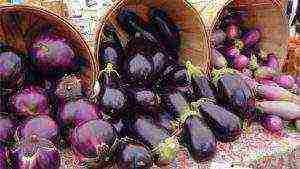 The cost of eggplants on the market during the season is low, but for a long time in all regions of the country, gardeners have gotten used to growing this capricious southerner on their notorious six hundred square meters. No wonder his homeland is hot India, an abundance of sunlight and high air temperatures are ideal conditions for good fruiting.
The cost of eggplants on the market during the season is low, but for a long time in all regions of the country, gardeners have gotten used to growing this capricious southerner on their notorious six hundred square meters. No wonder his homeland is hot India, an abundance of sunlight and high air temperatures are ideal conditions for good fruiting.
However, in Siberia, in any garden, you can find low bushes with purple fruits. The inhabitants of the harsh climate have such an opportunity thanks to the work of breeders who have developed the best varieties of eggplant for Siberia, which successfully grow and delight with the harvest. The secret is that early and mid-early species are the most suitable.
Purple bunch
 Long purple eggplant, growing period 95-130 days, absolutely lives up to its name. It grows in length up to 25 cm, in diameter about 6 cm. Fruits are so heap that in appearance several fruits look like a bunch. Smooth cylindrical shape along the entire length has an attractive presentation, taste without the usual bitterness. Lying, does not lose quality during long-term storage. The mass of the vegetable is about 250 grams. The yield is good, from a square meter to 5 kg. The peculiarity of the variety is that it is preferably grown in a greenhouse, does not like drafts and hypothermia. With a lack of sunlight and heat, the yield drops sharply. The positive quality of this species is that it is an upright, strong bush.
Long purple eggplant, growing period 95-130 days, absolutely lives up to its name. It grows in length up to 25 cm, in diameter about 6 cm. Fruits are so heap that in appearance several fruits look like a bunch. Smooth cylindrical shape along the entire length has an attractive presentation, taste without the usual bitterness. Lying, does not lose quality during long-term storage. The mass of the vegetable is about 250 grams. The yield is good, from a square meter to 5 kg. The peculiarity of the variety is that it is preferably grown in a greenhouse, does not like drafts and hypothermia. With a lack of sunlight and heat, the yield drops sharply. The positive quality of this species is that it is an upright, strong bush.
You dreamed about him
 From germination of seeds to ripening, 95-105 days pass for the popular eggplant variety Gardener's Dream, without much hassle. The description of the variety is as follows: a low, erect plant, up to 80 cm high. Fruits are oblong 180-200 grams, up to 20 cm, glossy, dark purple. The juicy white pulp is not bitter. The yield is high - about 6 kg per square meter. Feature: Impressive bushes require adequate space, at least 40 cm between the beds. The most weighty plus of the variety is its resistance to late blight.
From germination of seeds to ripening, 95-105 days pass for the popular eggplant variety Gardener's Dream, without much hassle. The description of the variety is as follows: a low, erect plant, up to 80 cm high. Fruits are oblong 180-200 grams, up to 20 cm, glossy, dark purple. The juicy white pulp is not bitter. The yield is high - about 6 kg per square meter. Feature: Impressive bushes require adequate space, at least 40 cm between the beds. The most weighty plus of the variety is its resistance to late blight.
Noble robber in the garden
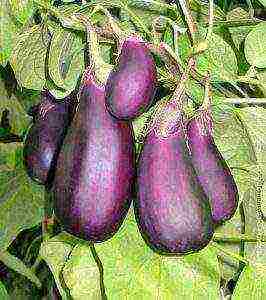 The delicate lilac color differs from its counterparts Robin Hood eggplant, an even earlier variety with a ripening of 90-100 days. The plant is short, branched, strong. Fruits with a thickening at the end, about 300 grams. Feature - he does not like crowding, it is better to give him more space in the garden. 5 plants per meter are ideal conditions. Positive quality is one of the most unpretentious species, it bears fruit almost always and everywhere.
The delicate lilac color differs from its counterparts Robin Hood eggplant, an even earlier variety with a ripening of 90-100 days. The plant is short, branched, strong. Fruits with a thickening at the end, about 300 grams. Feature - he does not like crowding, it is better to give him more space in the garden. 5 plants per meter are ideal conditions. Positive quality is one of the most unpretentious species, it bears fruit almost always and everywhere.
Ebony beauty
 The early hybrid eggplant is Giselle, a beautiful dark color. Compact bush. Fruits grow weighing up to half a kilogram, 20-23 cm long. In greenhouses, the yield is up to 14 kg, on the ground - 7 kg per square meter. Feature of the variety: eggplant Giselle F1 like no one else like light sandy and sandy loam soil. Plus - high cold hardiness. Under certain conditions, it can be stored for a very long time, easily transfers transportation.
The early hybrid eggplant is Giselle, a beautiful dark color. Compact bush. Fruits grow weighing up to half a kilogram, 20-23 cm long. In greenhouses, the yield is up to 14 kg, on the ground - 7 kg per square meter. Feature of the variety: eggplant Giselle F1 like no one else like light sandy and sandy loam soil. Plus - high cold hardiness. Under certain conditions, it can be stored for a very long time, easily transfers transportation.
Vivat, king!
One of the most productive of the early ripe eggplants, the King of the Market is a hybrid, the length of the vegetable is about 23 cm, diameter is 6 cm.
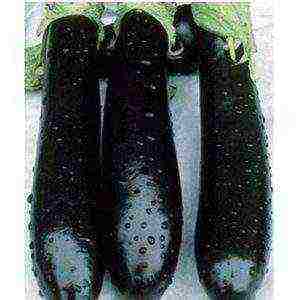 Fruits are smooth, shiny, beautiful color. The pulp is tender, snow-white, not bitter. Seeds for seedlings should be planted no later than the end of February in order to achieve more than 10 kg of the usual yield from the hybrid. The peculiarity of the variety - due to the high yield, it needs a mandatory garter of the bush, it may not withstand the severity of the fruit. An interesting feature is that from the very beginning the fruits are purple, therefore ripening is assessed according to other parameters.
Fruits are smooth, shiny, beautiful color. The pulp is tender, snow-white, not bitter. Seeds for seedlings should be planted no later than the end of February in order to achieve more than 10 kg of the usual yield from the hybrid. The peculiarity of the variety - due to the high yield, it needs a mandatory garter of the bush, it may not withstand the severity of the fruit. An interesting feature is that from the very beginning the fruits are purple, therefore ripening is assessed according to other parameters.
Not just early, but ultra-early maturing
 Such a characteristic is given by seed producers to the eggplant variety Maria, whose ink-purple fruits ripen quickly in ordinary beds. Vegetables of this type grow long, weighing up to 220 grams. It is resistant to typical Siberian daily temperature drops. Under the film, up to 5 kg of tasty, non-bitter fruits are obtained from the garden.
Such a characteristic is given by seed producers to the eggplant variety Maria, whose ink-purple fruits ripen quickly in ordinary beds. Vegetables of this type grow long, weighing up to 220 grams. It is resistant to typical Siberian daily temperature drops. Under the film, up to 5 kg of tasty, non-bitter fruits are obtained from the garden.
Especially for Siberia
 Indispensable for growing in difficult conditions, the Salamander eggplant, bred specifically for the Siberian regions. It is resistant to sudden changes in temperature from frost to heat, which is a distinctive feature of the weather in Yakutia and some regions of Siberia. Description: both a bush and medium-sized fruits. The pulp is dense, light, without bitterness. Prefers light, fertile soil containing organic debris.
Indispensable for growing in difficult conditions, the Salamander eggplant, bred specifically for the Siberian regions. It is resistant to sudden changes in temperature from frost to heat, which is a distinctive feature of the weather in Yakutia and some regions of Siberia. Description: both a bush and medium-sized fruits. The pulp is dense, light, without bitterness. Prefers light, fertile soil containing organic debris.
Siberian breeding product
This variety was bred at a Siberian experimental station, therefore, it is in this region that the early maturing eggplant is most popular, only 120-130 days pass from germination to harvest. Pear-shaped cultivation products, small in size. The bush is low, standard. From 4-6 bushes, 4-6 kg of vegetables are obtained. 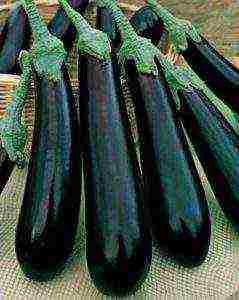 The hybrid variety is Siberian early maturing eggplant 148, ideal according to the inhabitants of South-West and West Siberia. Early fruiting, a compact bush, a drop-shaped vegetable up to 10 cm in size - all these positive characteristics make it possible to achieve high results even for those who first decided to grow eggplants.
The hybrid variety is Siberian early maturing eggplant 148, ideal according to the inhabitants of South-West and West Siberia. Early fruiting, a compact bush, a drop-shaped vegetable up to 10 cm in size - all these positive characteristics make it possible to achieve high results even for those who first decided to grow eggplants.
In agricultural technology, early maturing eggplant 148 requires compliance with certain conditions, including in the selection of soil for seedlings. She must be:
- easy;
- loose;
- neutral;
- fertile.
In order for all seeds of the Siberian early ripening eggplant variety to grow, the temperature in the room must be at least 20 degrees Celsius. Plant the shoots at a distance of at least 60 cm from each other.
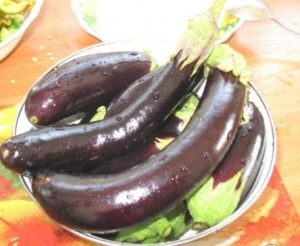 Galina eggplant, one of the most praised early varieties, is especially favored by the chefs for its delicate and piquant taste. Smooth, with a thickening at the end, glossy fruits weigh 250 g. Compact bush, 80 cm high. Suitable for all types of greenhouses, as well as for open ground. During the season, up to 6 kg of vegetables are harvested from an area of 1 m.
Galina eggplant, one of the most praised early varieties, is especially favored by the chefs for its delicate and piquant taste. Smooth, with a thickening at the end, glossy fruits weigh 250 g. Compact bush, 80 cm high. Suitable for all types of greenhouses, as well as for open ground. During the season, up to 6 kg of vegetables are harvested from an area of 1 m.
Green eggplant, unusual among its dark-skinned counterparts, has a special mushroom flavor of delicate loose flesh. Fruits are round-shortened, pear-shaped, green. Ripeness occurs on day 115. The vegetable reaches a mass of 300 grams. Resistant to many negative factors: cold, temperature changes, pests, diseases. Popular for its quick preparation. After heat treatment, the taste acquires a special piquancy of shades of greens and mushrooms.
A real Russian hero
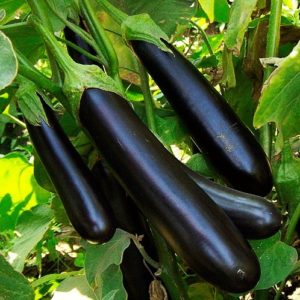 Ilya Muromets, a significant representative of the eggplant family, has every right to its name. The fruits of this plant are truly gigantic in size, weighing up to 800 grams, up to 40 cm long, up to 10 in diameter, ripening of the fruits occurs as early as 115-120 days from the emergence of shoots. A distinctive feature - the fruit does not contain seeds, the pulp is juicy, non-bitter. It feels best in a greenhouse covered with plastic.
Ilya Muromets, a significant representative of the eggplant family, has every right to its name. The fruits of this plant are truly gigantic in size, weighing up to 800 grams, up to 40 cm long, up to 10 in diameter, ripening of the fruits occurs as early as 115-120 days from the emergence of shoots. A distinctive feature - the fruit does not contain seeds, the pulp is juicy, non-bitter. It feels best in a greenhouse covered with plastic.
Small but remote
 One of the shortest species of this culture is the Severyanin eggplant, with a height of only 50 cm. 115 days pass from disembarkation to ripeness. Fruiting in any soil, the yield is good. The shape of the fruit is pear-shaped, weighing 300 grams, which is a sufficient load for such a bush. Therefore, it often needs supports so that the fruits do not touch the ground. Resistant to late blight and rot.
One of the shortest species of this culture is the Severyanin eggplant, with a height of only 50 cm. 115 days pass from disembarkation to ripeness. Fruiting in any soil, the yield is good. The shape of the fruit is pear-shaped, weighing 300 grams, which is a sufficient load for such a bush. Therefore, it often needs supports so that the fruits do not touch the ground. Resistant to late blight and rot.
News for gardeners
 Excellent resistance to pests, namely, spider mites and Colorado beetles, is distinguished by the eggplant Samurai Sword, so named for its unusual club-shaped shape up to 200 grams. This is one of the new varieties that has already firmly taken its niche among the more famous brethren. Technical maturity occurs on day 120.
Excellent resistance to pests, namely, spider mites and Colorado beetles, is distinguished by the eggplant Samurai Sword, so named for its unusual club-shaped shape up to 200 grams. This is one of the new varieties that has already firmly taken its niche among the more famous brethren. Technical maturity occurs on day 120.
Overseas caviar
 The high-yielding eggplant Ikorny, due to its almost seedless pulp, is suitable specifically for the preparation of the canned product of the same name. During the season, 7-7.5 kg of vegetables of excellent taste are obtained from the garden. Suitable for any soil, picky. The plant is spreading, due to its bright leaves, it has a decorative appeal. It needs a support under the fruit-bearing branches, as weighty teardrop-shaped fruits weigh them down to the ground.
The high-yielding eggplant Ikorny, due to its almost seedless pulp, is suitable specifically for the preparation of the canned product of the same name. During the season, 7-7.5 kg of vegetables of excellent taste are obtained from the garden. Suitable for any soil, picky. The plant is spreading, due to its bright leaves, it has a decorative appeal. It needs a support under the fruit-bearing branches, as weighty teardrop-shaped fruits weigh them down to the ground.
A low, compact eggplant Galich is famous for its strong stem and wavy leaves along the edges. The fruits are cylindrical, reaching 200 grams by the time of ripeness. The pulp is juicy, without bitterness, spicy. Suitable for canning and cooking caviar at home.It is better to plant seeds on seedlings in disinfected soil in early March, and in the ground in May-June, with seedlings with 5 true leaves.
Secrets of Success in Eggplant Breeding
According to experienced gardeners, amateurs and professionals, the best eggplant varieties for Siberia are those that are bred at experimental stations in this region.
But many other representatives of the species, seemingly not intended for the Siberian summer, delight the owners with an abundance of fruits. It does not always depend on the climate, but rather on the experience and desire to achieve the goal.
It is not difficult to achieve high yields of this crop if you follow certain rules:
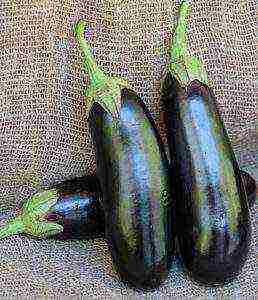 Cultivation is carried out through seedlings. Sowing in late February - early March. Cover the seeds shallowly. The soil should be loose, moisture should not stagnate on the surface.
Cultivation is carried out through seedlings. Sowing in late February - early March. Cover the seeds shallowly. The soil should be loose, moisture should not stagnate on the surface.- Seedlings do not dive, because after that they are sick for a long time.
- The soil for planting should be fertile, but not oily. Better with the addition of organic matter, peat.
- There should be a distance of 40 to 60 cm between the eggplant bushes, depending on the variety. Eggplants love space and air. Otherwise, they begin to hurt and rot.
- Even if it is planned to grow in open ground, at first the planted bushes must be carefully sheltered from the scorching rays of the sun during the day and from frost at night. Best of all with a film or covering material.
- Eggplants are responsive to loosening, mulching, feeding.
- It is necessary to protect the plant from the Colorado potato beetle and spider mites.
You should not wait for a seasonal sale on the market, something that is grown with your own hands tastes much better. Moreover, even an inexperienced gardener can do it. Read the article: Eggplant in a greenhouse: growing and care with a detailed description.
About eggplant, a culture-traveler, just right to write adventure stories. How many kilometers of roads it has covered, nautical miles has sailed, national culinary traditions have endured - you cannot count. Having started its journey from warm East India, eggplant reached the cold Russian north, where it adapted to the peculiarities of the climate and turned from an exotic overseas nightshade berry into an ordinary vegetable.
The problem of diversity and difficulty of choice
The journey from the 9th century to the 20th century brought the new vegetable not only global expansion, but also significant varietal enrichment. If in 1910 Russia knew only two varieties of eggplant - Odessa early and Bulgarian semi-long - then the beginning of the third millennium gave birth to hundreds of new varieties, hybrids and semi-hybrids. Now the main problem of farms and summer residents was not the process of finding at least some seeds that rarely go on sale, but the process of choosing the right varieties from a huge assortment, oriented to any climatic zone of Russia and the Near Abroad.
Today eggplant is cultivated everywhere - from Kaliningrad to Kamchatka. And even Siberia with its strongest changes in day and night temperatures is no exception. There are a whole galaxy of varieties for cultivation in greenhouses and outdoors. At the same time, you can choose the desired shape of the purple handsome man, and its preferred length, and even the color from milky white to bright purple. The wealth of choice is such that the founders of the blue vegetable never dreamed of.
Since it is impossible to highlight the description of all varieties in one article, we will restrict ourselves to only a small part of them, intended specifically for Siberia and zones similar in climate.
Climatic features of the Siberian region
To choose the right variety, you need to clearly understand the weather and climatic conditions of the region. The growing season in most of Siberia begins in early May and ends by the end of September. At the same time, the beginning of May is rather cold, with daytime temperatures no more than +10 +12 0С and night frosts on the soil and in the atmosphere. Such an environment is not suitable for planting heat-loving crops.Therefore, if we are talking about open ground, then eggplants are planted in it only after May 28, when the threat of return frosts has passed, and the air temperature stabilizes to +22 +25 0С during the day and +10 +12 at night.
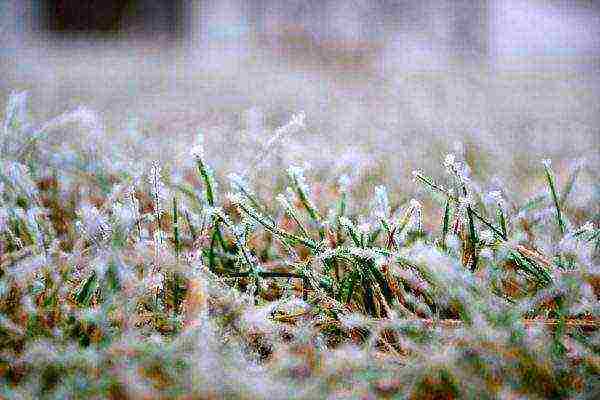
In the open ground in Siberia, eggplants are planted only at the end of May, in order to avoid spring frostbite.
But this is not all the troubles of the weather. June in the region is characterized by heavy rainfall, often with hail and sudden temperature fluctuations from cold to warm. September in Siberia is a warm month during the day, but it is vegetative only conditionally. Perennial plants begin to prepare for winter. And annuals lose active growth, complete the formation of fruits with seeds, but no longer form new ovaries. With such a peculiar vegetative season, special types of eggplant are required, which not only tolerate atmospheric changes well, but also mature not in 150 days, but in a shortened period of 95–130 days.
The best varieties of eggplant for Siberia for open ground
There are many varieties zoned for Siberia. In addition to the early ripening period, their advantages are strong endurance, high resistance to diseases, low susceptibility to harmful insects and stable productivity, which is in no way inferior to varieties of medium and late ripening periods. At the same time, all the beneficial substances are preserved in the fruits, thanks to which eggplant has become one of the dietary food products recommended for many gastrointestinal disorders, anemia, liver, kidney and heart diseases. "Vegetable of longevity" - this is how some peoples dubbed the eggplant when they understood its medicinal properties.
Classic purple varieties
The phrase "eggplant in Siberia" today is not absurd and not consonant with the expression "an elephant in a china shop." Eggplant in Siberia is 100% appropriate. Although there is one "but". The fact is that, due to the peculiarities of the climate, the presence of this culture in the open field is very conditional. After all, the period of 10-12 days after the transplant, 30 nights in June and 20 nights in September, he will most likely spend under a PVC film, protecting himself from return frosts in June and changes in day / night temperatures. And only 50-60 full days out of 95-130, really, in the open field. Therefore, when we say "varieties for open ground", we mean exactly this alignment in agricultural technology. This is Siberia, not the southern coast of Crimea.
Let's start the review of varieties with those of them that have become Siberian classics, since they received full cultivation priority in the region.
Diamond
The Almaz variety, tested for reliability, has not lost its relevance since 1983. It attracts not only its precious name, but also its genetic characteristics. Recommended for cultivation everywhere, except for the North-West region and the Far North. It is declared by breeders as mid-season - the ripening cycle from germination to full technical ripeness is 110-140 days. The plant does not exceed 60 cm in height. Branching from the central trunk is dense and friendly - this contributes to the formation of a productive early harvest.

The Dark Purple Eggplant Diamond, bred in 1983, has become a folk classic today.
The beautiful cylindrical fruit is dark purple in color. The average weight is from 100 to 160 g. There are no thorns on the calyx. The pulp has a greenish tint, without bitterness. The yield by the time of technical maturity is 2.1 - 7.5 kg / sq. M, which in terms of conversion will amount to 2 kg per sq. M. m or from 6 to 20 medium fruits from one bush. The scope is large. But the specific yield depends on both the growing region and the fertility of the soil.
Significant disadvantages of Diamond are:
- elongation of the fruit, as a result of which they come into contact with the ground;
- the presence of many small seeds that make cooking difficult.
The variety is recommended for large and small farms, as it is inexpensive to maintain, relatively resistant to mosaic and pillar, moderately sensitive to top rot, fusarium, verticillosis, and is also adapted to mechanized harvesting and transportation.
Diamond
The Almazny variety is not as old-timer in Russian fields as Almaz. It exists in the state register of the Russian Federation only since 2010, but over the past eight years it has established itself positively in all respects. Bred by the Astrakhan Research Institute, the variety has spread to all regions of Russia and the Near Abroad, without exception.Feels great in Siberia too. It is characterized by early maturity with a ripening period of up to 120 days and the presence of a calyx without thorns.
By weight, the dark purple Almaznoy fruit has bypassed its fellow Almaz - the average weight is declared at 150–220 g. The pulp is white, while the taste is not inferior to other sweet varieties: there is no bitterness, the taste after heat treatment is excellent.
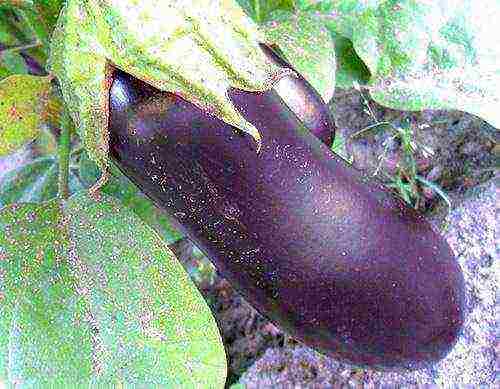
Almazniy and Almaz are somewhat similar, but in terms of fruit weight, the first one bypassed its brother: 220 grams versus 160
The yield according to the characteristics of the originators of the variety reaches 2.8 - 3.1 kg / sq.m, or up to 1 kg per bush. The uniformity of fruits, amicable return and stability of fruiting are noted. The variety is not recommended for industrial cultivation due to its relatively low yield. But for small private farms it is quite acceptable.
Bataysky
The Bataiskiy variety is recommended for cultivation in Eastern Siberia. However, summer residents from Altai Territory, Kemerovo, Novosibirsk, Tyumen regions also recognized this culture as suitable for their regions. Paying maximum attention and care to her, they achieved high yields and appreciated the even cylindrical fruits of black-purple color.
The variety has been known since 1981 and has not lost its fans for almost 40 years. There is a high growth of the plant - up to 70 cm, but weak spreading, which allows planting roots with an interval of 30–35 cm. The fruit reaches its technical ripeness in 120–140 days from the moment of germination. The length is fixed from 12 to 19 cm, the diameter in the middle part is from 4.5 to 8 cm. The weight range is from 140 to 220 cm, which makes it possible to obtain a whole size range of fruits. There are no voids inside, just as there is no bitterness in the taste. The white flesh is of medium density and a moderate number of seeds.
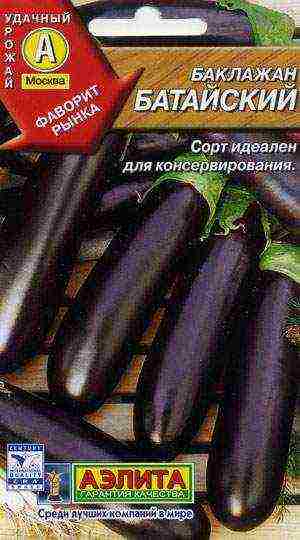
The main disadvantage of Bataysky is the hanging of the fruits and touching the ground, which is fraught with infection with putrefactive bacteria
The disadvantage is the same as that of Almaz: the fruits hang down and touch the ground, which is fraught with the spread of putrefactive diseases, if they are not removed in time. There is also an instability to fusarium wilt.
Black brilliant
Another variety that has gained popularity is the Black Diamond. It has been known since 2009 and has an early ripening period. The stem is distinguished by its light anthocyanin coloration with slight pubescence. There are practically no thorns on the calyx. The glossy surface of the dark purple cylindrical fruit resembles a wax toy. The declared weight is 200 g. The taste is excellent.

The glossy surface of the perfect deep purple cylindrical fruit resembles a wax toy
The yield can reach 6.5 kg / m2 or almost 1.5 kg from one bush. But at the same time, a reservation is made that such performance is possible only under the film cover.
Purple Miracle F1
The hybrid variety Violet Miracle is also considered a long-liver. It was entered in the State Register of the Russian Federation in 1999 and still has a laudable reputation. The compact and medium-sized Miracle bush can be called early ripening, because ripening occurs 95 - 100 days after germination. The stem has no anthocyanin coloration; there are no thorns on the fruit calyx.
The shape of the fruit is interesting. It is an elongated cylinder with a smooth, glossy skin and a pointed tip. Weight in the range of 100-350 g. The pulp inside the fruit is greenish with a moderate amount of seeds, but without bitterness.

Purple Miracle gives a stable yield up to 5 kg / sq. m, or up to 10 fruits from one bush
When grown in unheated greenhouses and outdoors, the Purple Miracle gives a stable yield of up to 5 kg / sq. m, or up to 10 fruits from one bush. At the same time, excellent transportable properties and keeping quality of fruits are noted with full preservation of the presentation.
The value of the variety is also in its high resistance to verticillium wilt and spider mites.
Japanese dwarf
I cannot fail to mention the Japanese Dwarf variety in the section on eggplant classics. Zoned for Russia on the Novosibirsk experimental plots in 2004, it became native to many Siberians.
The Japanese Dwarf does not require special care, but at the same time it is not inferior in yield to large-fruited varieties
Reviews of classic varieties of eggplants
White varieties of eggplant
Traditionally, a purple plant looks especially tempting if it has white fruits. There are many such varieties, and they are not at all ranked among deviants or albinos. They are quite healthy edible vegetables with all the qualities of an eggplant.
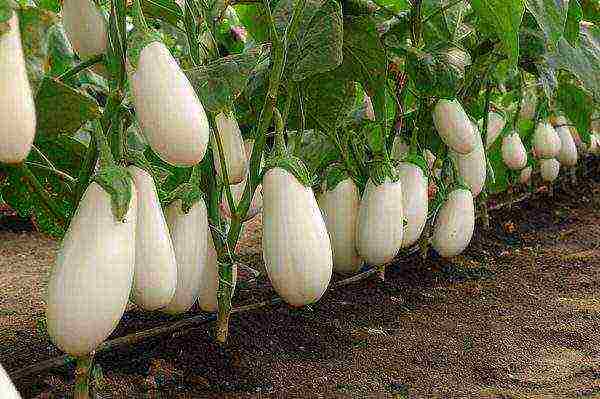
The oval white fruits of Bibo have a small mass - 190-210 g, but have a pleasant taste
Of the most famous, adapted for growing in the open field in the Siberian climate, the following can be called:
- Bibo F1... A hybrid of Dutch selection, intended for personal subsidiary plots. Refers to early maturing. The bush is undersized, semi-spreading. Oval white fruits harmonize beautifully with the anthocyanin coloration of the stem. Small weight - 190–210 g. They differ in average yield and excellent transportable properties. Among the disadvantages are thorns on the fruit cups.
- Mushroom Taste... The variety belongs to the early maturing species. The fruit is short, cylindrical with white pulp and an average weight of up to 180 g. Taste after heat treatment is excellent. Productivity up to 6 kg / sq. m or up to 1.5 kg per bush.
- Milkman... Variety of the new generation of selection in 2017. Considered medium early. On a square meter, 5 bushes may well fit, since their average indicators in terms of spreading and height are noted. The stem is green, pubescent. Thorns are rare. The fruit is declared as clavate with a large diameter and weight up to 270 g. The yield is high - one bush can give up to 8 large fruits.
- Pelican F1... The hybrid has existed since 2000, designed for small farms. Technical ripeness occurs on day 115. Outside and inside, the fruit is white, there is no bitterness. The harvest gives back together. The fruits are well stored and can be transported well.
- Ping Pong F1... Ping Pont and Pelican are almost identical hybrid varieties, because both the ripening times are the same, and the recommended turnover during cultivation is the same, and the structure of the bush is similar, and even the thorns of the two crops are the same. The difference is in the fruits. If the Pelican has them long, then the Ping Pong have round ones, from a distance they look like tennis balls. Accordingly, the weight of the fruit is small - only 90 g. But the yield is quite profitable - up to 7.5 kg / m2 or up to 2 kg from one bush.
Photo gallery: white eggplant varieties
Striped varieties
There has been a significant leap forward in this segment of breeding over the past 20 years. Dozens of new varieties of eggplant have been developed with colors ranging from lilac-milky to violet-blue with striped blotches. They were given appropriate names so that consumers could not confuse them with white or purple classics.
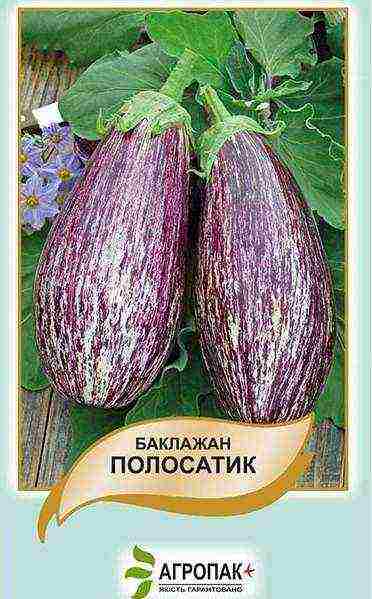
The stripe fruit has an ovoid shape of small diameter and weighs only 80 g.
For outdoor cultivation, the following can be recommended:
- Striped flight. Mid-season variety, tall bush. The fruit is glossy with frequent white-purple stripes. Weight 190-200 g. Average yield.
- Striped. A compact, low shrub of early maturity. The fruit is ovoid, small in diameter, matte. Weight is only 80 g. Productivity is good, up to 3 kg / m.
- Boatswain. A low-growing bush, belongs to the early maturing varieties. The stem has an anthocyanin coloration. The fruit is in the form of an ellipse with a small diameter. An entertaining color with spots and strokes on a light green background, brought the variety to the top ten striped rating. Weight up to 180 g. Productivity with small fruits reaches 5.5 kg / sq. M.
- The sailor. Early ripe variety. The fruit is colored with a white and purple stripe. Quite large by weight - 380 g. The pulp after cooking is tasty, there is no bitterness.
- Sailor. In the State Register of the Russian Federation since 2000. Ripeness occurs 104 days after germination. The half-stem stem has no anthocyanin coloration, but there are thorns on the calyx. The fruits have a striped lilac-white color, the weight of one unit is 143 g. The value of the variety is in its high yield, resistance to fusarium and wilting.
- Overseas minke. New variety of selection in 2015. The bush is vigorous, early maturing. The egg-shaped fruit, reaching a mass of 500-900 g, is considered a real giant. The fruit-giants also correspond to the yield - up to 9.5 kg / sq. m.
- Marble. Early ripe variety. Semi-spreading, tall plant. The fruit is an elongated cylinder with mauve stripes. The maximum weight is 250 g. The taste is excellent, without bitterness. Productivity 4.9 kg / sq. m.
Photo gallery: striped eggplant
Spherical varieties
Ball-shaped eggplants are also in great demand. They are attracted not only by the shape that resembles a ping-pong ball, an egg, or a moon disk, but also their high immunity to diseases of nightshade crops.
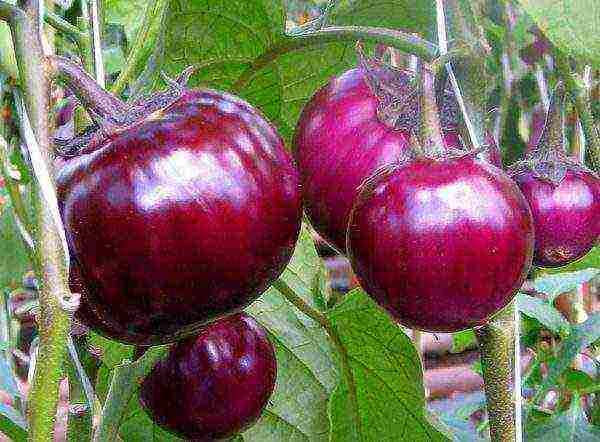
A hybrid of Bourgeois with a spherical fruit showed excellent taste
The eggplants presented in the table below are early or mid-early varieties with a ripening period of 95 to 125 days, which is quite suitable for growing in the climatic conditions of all regions of Siberia. All varieties have greenish or white flesh without bitterness. All are usable after heat treatment.
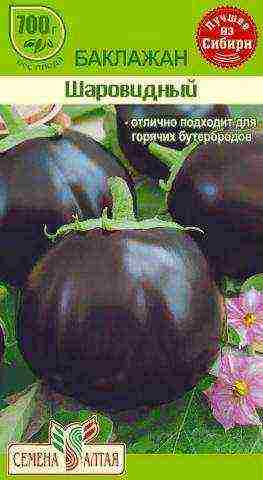
The fruit of the Spherical variety has an average weight of 600-700 g and a yield of more than 6 kg / sq.m
Table: varieties of eggplant spherical
Photo gallery: spherical eggplants for Siberia
New breeding 2017, suitable for open ground and PVC greenhouses in Siberia
Breeding work on the breeding of eggplants brings new varieties and hybrids every year. They cannot be ignored, for these are the latest novelties of our time. There are still few reviews on them, because monitoring and adaptation to specific regions are underway. Siberia is no exception.
Table: eggplants of the selection of 2017, zoned for Siberia and the Trans-Urals
Photo gallery: eggplant selection 2017 for Siberia
Exotic varieties for open ground and PVC greenhouses for Siberia
This group of eggplants has gained popularity due to their special shapes or unusual color shades. If vegetable growers are already accustomed to pear-shaped, cylindrical and spherical shapes, then the shape of the bean pod in eggplant is of interest, and colors such as green or red are curiosity. The varieties presented below are not whimsical and undemanding to weather conditions, and therefore may well be cultivated in Siberia and the Urals.
Green
The variety entered the State Register of the Russian Federation in 2009. Belongs to early maturing crops. It has an ellipsoidal green fruit. The strong gloss on the peel makes it look like a green pear. Weight from 200 to 250 g. Productivity and commercial qualities are on top.
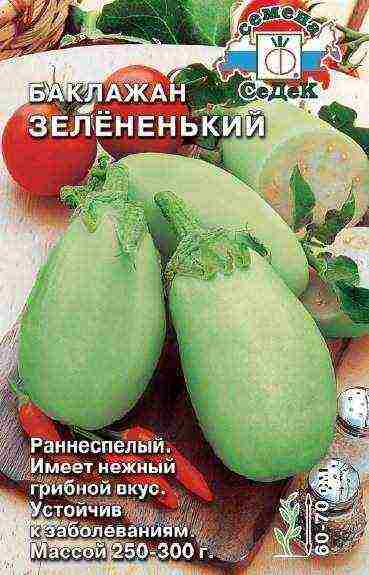
Zelenko's ellipsoid fruit entered the State Register of the Russian Federation in 2009 and immediately gained popularity
Finger
This eggplant got its start in 2013. Reaches technical ripeness by the end of August. The bush is semi-spreading, of medium height, the stem has an anthocyanin coloration. Fruits in clusters on which several fruits ripen. They have a violet-green hue and a very small diameter, which makes them resemble hanging bunches of asparagus beans. The mass of eggplant pods reaches only 30–40 g, but the size is not reflected in the taste. Suitable for consumption after heat treatment, as well as for long-term storage in the form of pastes and canned vegetables. In the characteristics of the variety, such fatty "pluses" as dryness and heat resistance are noted. Productivity 6.9 kg / sq.m.

The Finger variety bears fruit in clusters on which several fruits ripen - their shape, due to their small diameter, resembles hanging bunches of asparagus beans
Emerald F1
Emerald is a hybrid variety with white flesh inside. The green fruit has an oval shape and reaches a mass of 300 g. The bush is characterized by high yield rates, resistance to adverse weather factors and temperature fluctuations. In the State Register of the Russian Federation since 2007.

Emerald is characterized by high yield rates, resistance to adverse weather factors and temperature fluctuations
Icicle
The variety of Astrakhan breeders has been recommended for cultivation in almost all regions of Russia since 2008. The extravagance of the fruit lies in its shape and color. White, long, with a narrow tip and small diameter, it really resembles an icicle. The calyx does not have thorns, and this makes it easier to collect fruits, which can form up to 25 pieces on the branches of one bush. At the same time, the mass of one unit is small - only 100–150 g. The recommended interval for planting is 40–45 cm between bushes, as they are highly branching and reach a height of 80 cm.

White, long, with a narrow tip and a small diameter, the Icicle fruit weighs only 150 g, but up to 25 of them can ripen on a bush
Of the decorative forms of eggplant suitable for cultivation in Siberian regions, an example of a variety can be cited:
- Golden Egg, which is edible only if harvested unripe; at the stage of technical maturity, the eggplant is yellow in color and looks like a goose egg.
- Red Decor is a completely inedible variety, but gives the appearance of decoration on the bushes thanks to its small flat-round fruits of bright red color.
- The mantle is a variety of lemon-yellow striped color, reminiscent of the mantle of either the Colorado potato beetle, or the fairy king.
Photo gallery: decorative eggplants
The best varieties of eggplant for Siberia for unheated greenhouses
As noted above, eggplant is a thermophilic culture. The Siberian District, although adapted for many types of this culture, is still not suitable for especially delicate varieties if they are cultivated in open, unprotected areas. However, if you apply the rules of agricultural technology using PVC greenhouses, then some varieties of purple beauties can be obtained without sacrificing yield. Among them we will name the following:
- Black Suit - a high-yielding variety of late ripening, has pear-shaped fruits up to 18 cm in size, up to 7 cm in diameter and an average weight of 400 g. White pulp, decent taste.
- Galine F1 - a hybrid of French selection, entered the State Register of the Russian Federation in 2003. The fruit has a violet-brown teardrop-shaped color and a calyx with thorns. Weight from 200 to 500 g. Differs in a long storage period.
- Darling - mid-season variety, has been in the State Register of the Russian Federation since 2010. It has an ovoid fruit of light purple color weighing 300-360 g. The yield is average.
- Sancho Panza - a variety of medium ripening, it takes 130 days to fully ripen. The fruit is spherical, dark purple in color, calyx without thorns. The mass is simply gigantic - from 0.5 to 1.0 kg. The bush is productive in terms of yield, although it bears only 3-4 fruits.
- Mabel F1- a hybrid of Dutch selection, entered in the State Register in 2015. The bush is not spreading, of medium height. Easy to care for, easily tolerates stressful conditions, resistant to tobacco mosaic. The fruit is long, cylindrical, small in diameter. Fruit weight less than 300 g. Productivity 2.7 kg / sq. M.
Photo gallery: the best varieties of eggplant for PVC greenhouses
Video: popular varieties of eggplant
At first glance, eggplant seems to be a labor-intensive vegetable. In fact, growing it is no more troublesome than corn or beets. If you choose a variety that is zoned for the climate of the region, then you can fully enjoy both the aesthetic appearance of the unusual fruit and its exquisite taste after proper culinary processing. The main thing is to start, and everything will work out.
I love a garden, a vegetable garden, flowers. Rate the article:
(0 votes, average: 0 out of 5)
Eggplants and Siberia: seemingly incompatible concepts, but they are not. Of course, summer in Siberia can be very warm, but not for long, and eggplants need a long and hot summer. Therefore, until recently, this vegetable was exotic in the Trans-Urals. But the breeders have tried, and the enthusiasts have the opportunity to successfully grow this thermophilic crop in Siberia.
The best varieties for Siberia
Since eggplants have a long growing season, the choice for Siberia is obvious: only early or even super-early varieties can be grown here. Well, as a last resort, you can plant medium early ones, but they will already require more careful maintenance. Fortunately, there are now several dozen suitable varieties, and even the State Register of the Russian Federation recommends many varieties and hybrids of eggplant for cultivation in all climatic zones, without exception.
Open field eggplants
For eggplants that are not very simple in agricultural technology in the zone of risky farming, it is safer to use hybrids (F1), but some old varieties are not much inferior to them. Now there are a huge number of options, but in Siberia, if you want to grow eggplants in the open field, you must choose from early or even super early varieties and hybrids.
- Agate F1 is a high-yielding hybrid that has such a short growing season that sometimes you can do without seedlings: at the end of spring, you can try to sow prepared seeds under a film, and before the first frost some part of the crop will ripen. Fruits of the usual shape and color for eggplant, weighing 200-250 g, high yield. The hybrid is resistant to disease.
 Agate is one of the few eggplants that can bear fruit when directly sowing seeds in the garden.
Agate is one of the few eggplants that can bear fruit when directly sowing seeds in the garden. - Diamond is a mid-season well-deserved variety, grown since 1983. The time from emergence to technical ripeness is 109-149 days, this period strongly depends on climatic conditions. The bush is undersized, 45–56 cm high. Fruits are cylindrical, dark purple in technical ripeness, brown-brown in biological ripeness. Fruit weight 100–150 g. The taste is excellent. Relatively resistant to disease.
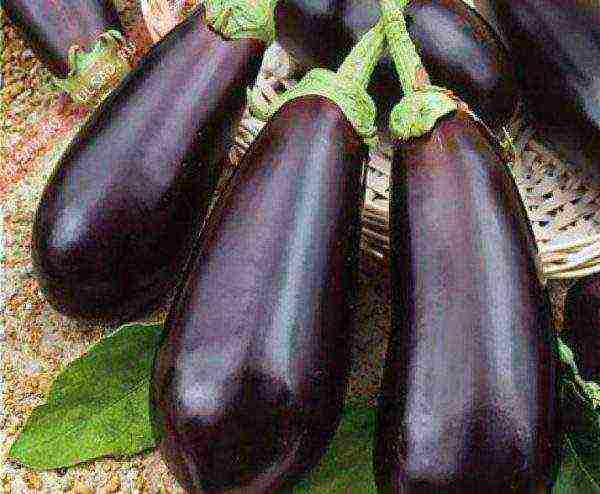 Diamond is one of the most famous varieties
Diamond is one of the most famous varieties - Bovine Heart F1 - mid-early hybrid, fruits are ready for consumption 4 months after sowing the seeds. Tall bushes, obligatory tying is required, oval-shaped fruits, weighing 300-400 g, shiny. Disease resistance is increased, fruiting is extended.
- Emerald F1 - eggplant with a strong aroma and taste of mushrooms, characterized by increased cold and disease resistance. From sowing the seeds to the readiness of the first fruits, it takes 100-110 days. Eggplants are green, oval, weighing up to 300 g. It is considered one of the easiest hybrids to grow, capable of bearing fruit in any climatic conditions.
 Emerald in appearance of the fruit lives up to its name
Emerald in appearance of the fruit lives up to its name - Bourgeois F1 is a tall, early ripening hybrid. The bush requires obligatory formation, but at the same time its highest resistance to diseases is noted. Bears fruit for a long time. Fruits weighing up to 500 g, similar in shape to tomatoes, are well transported and stored.
- King of the North F1 is a hybrid with reviews ranging from enthusiastic to not very good. It is capable of producing crops even at very low temperatures, does not like extreme heat. The yield reaches 14 kg / m2. It takes about three months from germination to harvest.The fruits are large, very long and thin, often lying on the ground.
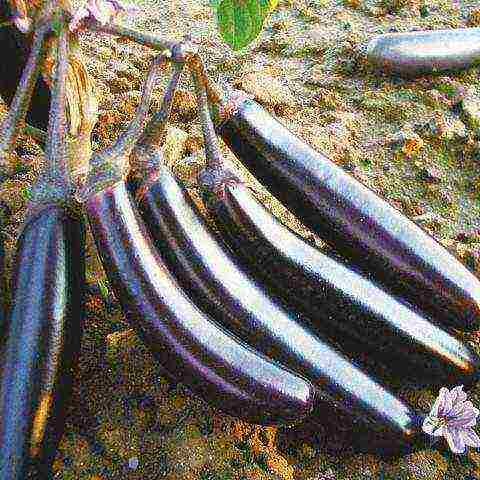 The king of the north sometimes looks like black bananas: the bunch touches the ground
The king of the north sometimes looks like black bananas: the bunch touches the ground - Batayskiy is a mid-ripening variety, from mass shoots to the technical ripeness of fruits it takes 118-142 days. Bushes above average height (45–75 cm). Fruits are cylindrical, dark purple to black in color, shiny surface. The mass of the fruit is 140–220 g. The pulp is white, without bitterness. The quality of the canned food is good and excellent. Productivity and disease resistance are average.
- Vera - recommended for home cooking and canning, early maturing. The period from full germination to harvesting is 100–118 days. Fruits are pear-shaped, weighing 120-200 g. Productivity is stable, but low.
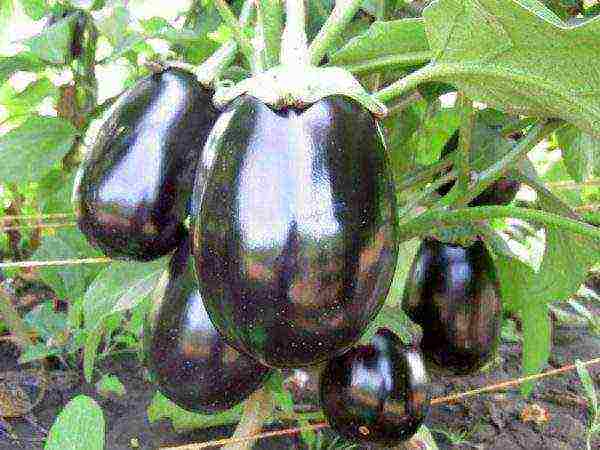 Vera is one of the traditional varieties for Siberia
Vera is one of the traditional varieties for Siberia - Salamander is a variety designed specifically for the Siberian region. It is resistant to sudden changes in temperature from frost to hot weather, which is typical for some regions and edges of Siberia. Both a bush and fruits of medium size, early maturing. The fruit is cylindrical, purple, weighing about 250 g. Good taste.
- Siberian argument F1 - included in the State Register for growing in open ground and under film shelters, mid-season. The plant is tall, the fruits are club-shaped, weighing about 150 g. The taste qualities of the products are excellent, the yield is at an average level.
Eggplant for the greenhouse
In principle, any eggplant can be planted in a modern greenhouse. But late-ripening varieties in Siberia may not ripen even in a greenhouse. In addition, saving space, vegetable growers try to grow tall and high-yielding varieties and hybrids in greenhouse conditions.
- Giselle F1 is a hybrid, universal in the use of fruits, can be grown both in greenhouses and in unprotected soil, but in good greenhouses the yield is much higher: up to 14 kg / m2. Fruits weighing up to 500 g, cylindrical, standard color for eggplants, are well stored. The first harvest is about 110 days after sowing the seeds.
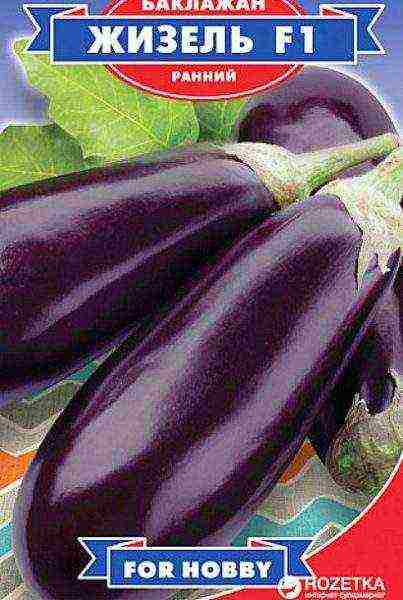 Giselle is popular in all climatic zones
Giselle is popular in all climatic zones - Romantic is an early ripe variety, differs from most varieties in the fruits of a pale lilac color, the shape of the eggplants is oval. The bushes are about a meter tall, the yield is average. The variety cannot be considered easy to grow, it can only be planted in good greenhouses: at the slightest cold snaps, it easily gets sick with fungal diseases.
- Balagur is a very early ripening variety, after sowing the seeds, the fruits can be tasted after 90 days. The bushes are tall, literally like a Christmas tree, hung with purple small fruits weighing about 100 g: up to 100 of them can grow on one bush. The taste is excellent. The variety is characterized by increased resistance to cold and disease, but requires careful formation of the bush.
 Balagur differs in that there are always a lot of fruits
Balagur differs in that there are always a lot of fruits - Maria is a high-yielding mid-season variety; in Siberia, it can be grown in greenhouses and under the simplest shelters. The bushes grow up to 70–75 cm. Disease resistance is quite high, the same applies to temperature changes. Early ripe. Fruits are cylindrical, weighing about 200 g. Good taste, average yield.
- Early maturing 148 is an old, widely known variety. It can be used for both open ground and greenhouses. Bushes are undersized, compact. The fruits are ready to harvest in 110 days after sowing the seeds. Low yield, pear-shaped fruits weighing 100-200 g. Unpretentious to conditions, bears fruit before the start of frost.
Growing conditions
From sowing the seeds to the readiness of the harvest, eggplants take a very long time: the earliest varieties bear fruit only after three months or more. Unfortunately, this vegetable can be planted in the garden only at the beginning of summer: it needs real warmth.Even in the south, eggplants are grown through seedlings to get early production, and in Siberia, the seedless method is practically inapplicable.
In principle, eggplants do not need anything supernatural: they need warmth, constantly moist and very fertile soil. Thermophilicity, as well as a long growing season, stopped the advancement of culture in harsh climatic regions for a long time. In Siberia, summer residents usually open their season on May holidays. At this time, the preparation of the eggplant beds begins, although it is better to do this in the fall.
If you have a good greenhouse, you can prepare a place for the eggplants in it. Although, of course, the best vegetables grow in the sun, and eggplant is no exception. But outside the greenhouse, they still have to prepare a temporary shelter: build a greenhouse from arcs, cover it with foil. Rows of eggplants should be arranged from north to south for better lighting and warming up by the sun. The best precursors for eggplant are cabbage, onions, pumpkins, and legumes. They should not be planted after tomatoes, peppers and potatoes.
 Eggplants definitely need space and good lighting.
Eggplants definitely need space and good lighting.
In the fall, the garden bed must be cleaned of plant debris and dug up with fertilizers. Eggplants are very demanding on the composition of the soil. It must be loose, breathable and saturated with humus and mineral fertilizers. At least one and a half buckets of humus or compost and a liter can of wood ash, as well as a tablespoon of superphosphate and potassium sulfate, are applied per 1 m². If the soil is clay, be sure to add peat, rotted sawdust, sand, give a high dose of compost.
Growing seedlings
Growing eggplant seedlings begins very difficult, but when the seedlings grow up, the main difficulties will be behind. Not every gardener takes up this business: eggplant seedlings require a lot of work and patience.
When to plant eggplants for seedlings
Eggplant seeds, especially unprepared seeds, germinate for a very long time, and prepared seeds do not germinate at the same time. The first shoots may appear in 6-8 days, and then the next couple of weeks may appear. Therefore, it is necessary to start preparing for sowing seeds even in winter, regardless of whether it is supposed to grow eggplants in a greenhouse or in open ground.
The best time for sowing seeds in Siberia is the first days of March. In this case, seedlings can be expected in mid-March, and the appearance of buds - at the end of May. Just after that, you can plant eggplants under the film shelters. With a later sowing, it will be possible to plant seedlings in open ground in June, when frosts have already ended in Siberia. Perhaps, shelter is not required, but the harvest will be less: before the onset of cold weather, only the first fruits will have time to ripen.
If it is planned to transplant seedlings into a greenhouse, sowing is carried out a week and a half earlier, after February 20. Of course, you can plant seedlings in a heated greenhouse even in April, but it is difficult to cook it in winter, even in a city apartment: there is not enough sunlight, the plants will stretch, and it may be too cool on the windowsill.
Video: growing eggplant seedlings
Sowing preparation
Soil preparation for seedlings is of great importance. If there is peat and sand, you can make the mixture yourself by mixing good soil and peat in half and adding ten percent of the sand.On a bucket of the resulting mixture, you should immediately add about 50 g of any complete mineral fertilizer and a handful of wood ash. Such soil should be disinfected by watering it with a pink solution of potassium permanganate.
To grow a dozen bushes, it is much easier to buy ready-made soil in the store, choosing the one that says about eggplants.
Seeds are also disinfected before sowing by preparing a solution of dark-colored potassium permanganate. The seed dressing process lasts 20-30 minutes, after which rinsing with clean water is required. If you plan to grow eggplants in the open field, hardening the seeds in the refrigerator is also mandatory (in a wet cloth for 3-4 days).
On the day before sowing, it is worth treating the eggplant seeds with a growth stimulant, this well increases germination and strengthens future plants. The easiest way is to use Epin-Extra or Zircon, strictly according to the instructions. You can also take the juice of the agave, dilute it 5 times with water and hold the seeds in the solution for several hours. Some gardeners germinate the seeds before sowing, but this is not necessary: after a few days of preparation, they have already swollen enough.
Sowing seeds for seedlings
Small cups are filled with prepared soil, where 2-3 seeds are sown (it is possible one at a time, if there are few seeds, but it is possible that empty cups will remain). The sowing depth is about 1.5 cm. A layer of snow is placed on top of a few centimeters. Having melted, it will evenly saturate the soil and compact the soil as much as necessary. In addition, snow water activates growth processes.
The cups should be covered with glass or transparent foil and placed in a warm place, the optimum temperature until emergence is 25-28 ° C. Until that time, bright light is not necessary, but immediately after the formation of the first "loops" on the surface, the cups will have to be transferred to a lighted place, otherwise the seedlings will quickly stretch out. If, while waiting for seedlings, the soil surface dries up, it must be carefully moistened with water.
Seedling care
The first shoots will appear in seven days, but most likely there will be few of them. As the "loops" appear, the cups should be transferred to a well-lit cool windowsill with a temperature of 16-18 ° C. Such a regime requires five days, then the temperature is gradually raised to 23-25 ° C (at night a few degrees less) and kept so until the end of growing seedlings. When it is clear which shoots are lagging behind others, they are carefully removed, leaving the strongest in the glass.
The seedlings are watered with settled water with a temperature of about 30 ° C, they do it 1-2 times a week, but in moderation: the risk of the seedlings getting sick with a black leg increases from waterlogging of the soil. Two weeks after germination, top dressing is given: 1 tablespoon of urea in a bucket of water. The cups are periodically turned towards the light source so that the seedlings do not bend.
Seedlings grow unevenly and transfer to larger pots must be done selectively. They do this very carefully, trying to remove the plant from the glass with all the available soil. The most suitable volume of containers for transshipment is about a liter, the soil is the same as in the cups. They fill it up enough to remove all the voids, and then pour it with warm water. Further care is the same as before transshipment.
 Ready-made eggplant seedlings are not a tiny plant at all
Ready-made eggplant seedlings are not a tiny plant at all
15–20 days before planting the seedlings in the garden, they temper it, taking it out to the balcony, first for a short time, and then for several hours. At the same time, the outside temperature should not be too low: 12-14 ° C for seedlings is not enough. In the morning of the day of transplantation, the seedlings are well watered. Seedlings ready for planting should have a height of 20-25 cm and 5-8 large green leaves. She becomes like this at about the age of 2.5 months. If the buds have already begun, great.
Transplanting seedlings into the ground
Eggplants can be planted in a good greenhouse in Siberia already at the end of April, but this is usually done in mid-May.If there is a lack of heat, a covering nonwoven material is additionally used. In open ground without shelter, planting seedlings in Siberia can be breaded in mid-June, when the soil warms up well. It is possible a couple of weeks earlier, but in this case, they first put arcs, cover them with a film, then replace the film with a double layer of spunbond, by mid-June they remove the shelter only during the day.
Landing in open ground
It is desirable that by the time of disembarkation, the average daily air temperature is at least 20 ° C. And since this cannot be expected in Siberia, the beds are prepared for a long time, trying to make sure that by the time of planting the soil warms up to at least 15 ° C. Experienced gardeners prepare warm beds for eggplants. To do this, choose a well-lit place, closed from northern winds.
Even in the previous summer, they dig a hole 20–25 cm deep to fit the size of the future garden. A variety of organic waste is poured into it: sawdust, foliage, small twigs, grass, garbage, etc. If there is peat, all this is generously poured onto them. Periodically water the future bed with infusions of manure or bird droppings. Fall asleep with clean fertile soil.
The sides of the resulting high bed are fenced off with boards, slate, etc. In the spring, the bed is sprinkled with wood ash and a week before the seedlings are planted, they are well spilled with warm water with the addition of mullein. After that, cover with a film for warming up. On the day before planting seedlings, the soil is loosened, and then holes are made according to the size of pots with seedlings. The planting scheme depends on the variety, but between the bushes should not be less than 35 cm, and between the rows - from 50 to 70 cm. They try to plant eggplants in the evening, when the sun is no longer baking.
 When planting seedlings, temporary shelter is required
When planting seedlings, temporary shelter is required
When planting, the seedlings are almost not buried, the tilt of the eggplants is also not required. Peat pots are planted whole; from others, seedlings are transferred with all the contents of the pot. It is advisable to immediately provide for pegs if the variety requires a garter. Plants in the garden are watered with warm water, and the soil around the bushes is slightly mulched. Be sure to cover the landings with non-woven materials.
Video: a bed for Siberian eggplants
Greenhouse landing
Eggplants in Siberia can be planted in a greenhouse in the last days of May, and in a greenhouse 1–2 weeks earlier. In greenhouses, especially polycarbonate greenhouses, the required temperature conditions are created early for eggplants. When planting seedlings, you need to pay attention to the temperature of both the air in the greenhouse and the soil, it should not be colder than 14 ° C.
In advance, you need to carefully prepare the beds in the greenhouse. In the fall, all plant residues should be destroyed and the soil prepared. If plant diseases have been noted, it is better to change the soil completely. In the fall, it is worthwhile to form a bed by digging up the soil with fertilizers. A week before planting the seedlings, the garden bed is watered with a light blue solution of copper sulfate and covered with a film.
After a couple of days, the film is removed and the soil is allowed to reach the state where it will be possible to work with it. They loosen deeply, level them with a rake and plant seedlings. Landing patterns are the same as in the open field. For tall varieties, it is convenient to use a checkerboard planting. Planting technology is the same as outside the greenhouse.
Video: planting seedlings in a greenhouse
Sowing seeds in the garden
In the south, when growing eggplant, you can do without seedlings. But in Siberia, this can be done only at great risk, and by choosing super-early varieties and hybrids for such cultivation. At the same time, there is not even a serious advantage over open ground in the use of greenhouses.
In order to have time to get the harvest of the earliest eggplants, they must be sown in the garden at the very beginning of May. At this time, in Siberia, it is only the first time they go to the dacha, so the garden bed must be prepared in the fall, then a film shelter should be built at the same time. By the time of sowing, the soil at a depth of 10 cm should warm up to at least 15 ° C. You can pour hot water over the garden bed, then cover it with plastic wrap.
Seeds are sown very densely: their germination in Spartan conditions may be insufficient. In rows, which are arranged after 50-60 cm, seeds are sown every 5-6 cm. After the emergence of shoots, the planting is thinned several times, removing the weakest specimens. The film is removed only at the onset of real summer.
Planting care
At first, eggplants grow very slowly in the garden bed, growth resumes in two weeks, when the seedlings take root. At first, care is needed minimal: you just need to keep the soil slightly moist and loose. Throughout the summer, care includes watering, feeding, loosening and shaping the bushes.
Eggplant in the open field
The soil in the eggplant bed should be slightly damp at all times. Eggplants require a lot of water, but excessive waterlogging should be avoided. It is necessary to water only with water heated in the sun, at the root. In Siberia, they try to plant seedlings already with buds, and until they bloom, planting is watered once a week: in the morning or in the evening, spending about a bucket of water per 1 m2. As soon as the flowers have blossomed, it is necessary to water more often. Water temperature - not lower than 25 ° C.
Loosening is carried out after each watering or rain. Hilling of plants is not used in Siberia. Of course, weeds must be constantly controlled. Up to the setting of fruits, feeding is not needed, unless, of course, the bushes grow normally. But then the eggplants are fed often, twice a month. At the same time, at first, infusions of mullein or bird droppings are used, and during the period of mass growth of fruits, nitrogen should not be given, therefore, only superphosphate and potassium sulfate are used. You can replace this mixture with wood ash infusion.
Most varieties and hybrids of eggplant require bush formation, but outdoors in Siberia, eggplant is often allowed to grow naturally. Nevertheless, it is necessary at least to pinch off unnecessary stepchildren, while they have just appeared. Such an elementary operation allows the eggplants to save strength and direct them to the growth of fruits. The yellowing lower leaves are also removed. Some of the ovaries have to be sacrificed: in the short summer it is difficult to get more than 7–8 fruits on the bushes.
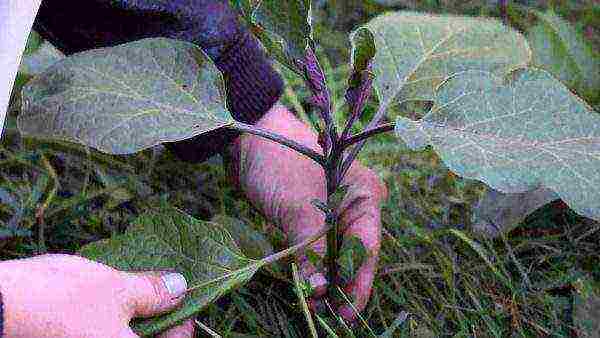 What appears from the axils of the leaves should be removed as early as possible.
What appears from the axils of the leaves should be removed as early as possible.
In Siberia, you have to constantly monitor the current weather. When it's hot outside, the beds are kept open, and if the temperature drops below 15 ° C, the bushes are covered with non-woven materials. At the end of August, the bed is again covered with foil. The most responsible growers also monitor the length of daylight hours: eggplants bear fruit better with a short day. Therefore, if possible, in the morning and in the evening they cover the planting from excess light.
Eggplant in a greenhouse
Eggplants in Siberia also require care in a greenhouse: in a damp, cloudy summer, you can hardly get more than two fruits from a bush, even in a greenhouse. This culture needs light and warmth. Sunlight should be maximal, and the temperature inside the greenhouse should be about 25-30 ° C, with almost no daily fluctuations. During the day in the greenhouse in the heat, you can easily maintain the temperature by simply opening the window and doors, but they must be closed at night. The containers with water placed in the greenhouse help.
It does not rain in the greenhouse, which means that watering is needed more often than outside. If, when growing in unprotected soil, it is possible not to come to the site in the middle of the week, you need to visit the greenhouse every day: without airing, in the hot season, the temperature can go off scale, and in the heat the eggplants are not tied.
The feeding regime does not differ from that when grown in the open field, and the formation of bushes is required. Indeed, in greenhouses they try to plant tall varieties, therefore, at least, the bushes should be tied to trellises or stakes.
 In greenhouses, a minimum of shoots are left on the bushes
In greenhouses, a minimum of shoots are left on the bushes
When the bushes grow up to 30 cm, the top is pinched on the main stem, after which lateral shoots begin to grow.Ultimately, no more than five of them are left. If a sufficient number of fruits have formed on the shoot, and the growth of the shoot continues, it also pinches the top. All shaping operations are stopped a month before the last harvest: now the plant's forces must be directed to ripening the fruits.
Diseases and pests
Most often, diseases lie in wait for eggplants in a greenhouse, where high humidity occurs. In the open field, pests are more annoying.
Major diseases
- Blackleg is a seedling disease; it rarely affects adult plants. From this fungus, the neck of the eggplant root darkens. No cure is possible. Diseased specimens are removed, the soil in their place is treated with bleach, in other places they are sprinkled with ash.
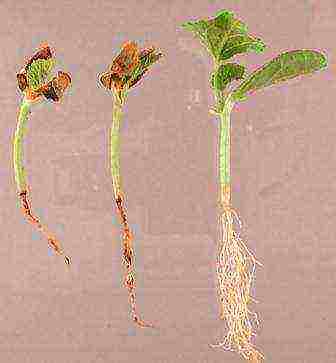 Black leg destroys seedlings on the spot
Black leg destroys seedlings on the spot - Mosaic is a viral disease, the leaves acquire a mosaic pattern, and the fruits are covered with yellow spots. It is difficult to cure such a disease; the plants have to be removed.
 Mosaic only outwardly looks harmless, it can destroy plants
Mosaic only outwardly looks harmless, it can destroy plants - Gray rot is a fungal disease that manifests itself at first with dark spots, then with a gray bloom. The diseased parts of the plant are cut off, the rest can be spread with a paste containing Trichodermin.
 Gray mold can leave without a crop
Gray mold can leave without a crop - Late blight is a dangerous disease of any nightshade crops. The leaves are covered with brown spots, dry up and disappear. The fruits rot and become deformed. Sometimes drugs Zircon or Fitosporin help.
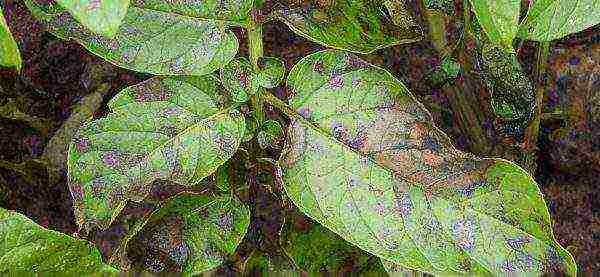 Late blight often develops in cold weather.
Late blight often develops in cold weather. - Powdery mildew is one of the most common fungi. First, white bloom appears on the lower leaves, then on the rest, passes to the fruit. Treatment - Fitosporin or Trichodermin.
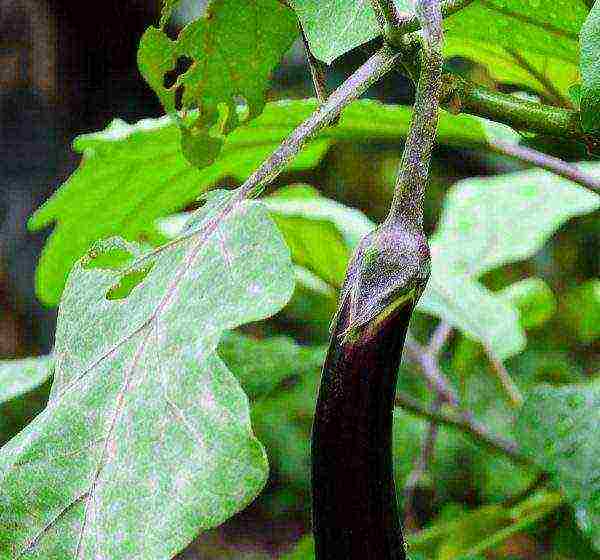 Powdery mildew is hard not to recognize: as if the whole plant is sprinkled with flour
Powdery mildew is hard not to recognize: as if the whole plant is sprinkled with flour
The most dangerous pests
- The Colorado potato beetle - a well-known minke whale - harms eggplants no less than potatoes, nibbling the leaves cleanly. Beetles have to be collected by hand and destroyed.
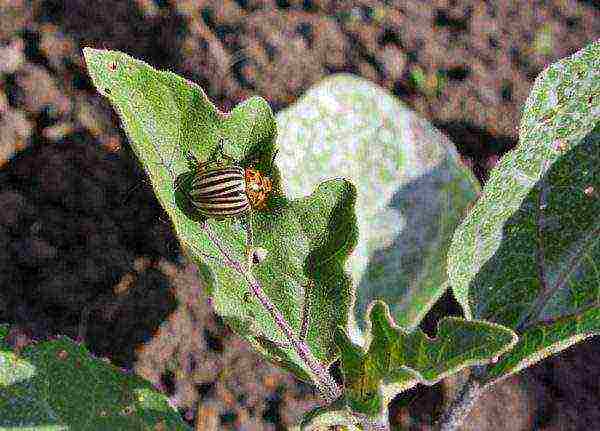 Colorado potato beetle: very beautiful, but no less harmful
Colorado potato beetle: very beautiful, but no less harmful - Aphids are a small insect that looks like small grayish dots at the bottom of the leaves, sucking juices from plants. You can use Fitoverm or Iskra-bio preparations for spraying.
 Aphids are able to suck all juices up to the death of plants
Aphids are able to suck all juices up to the death of plants - Slugs - eat both leaves and fruits. Everyone knows these nasty creatures, it is possible to fight them, but it is difficult. These can be both baits (they willingly go for beer), and special preparations that are scattered on the ground, for example, Slug-Eater.
 Slugs are very unpleasant creatures, capable of destroying all plantings
Slugs are very unpleasant creatures, capable of destroying all plantings - Whitefly is a butterfly that gnaws holes in leaves. In the open field, spraying with Confidor helps.
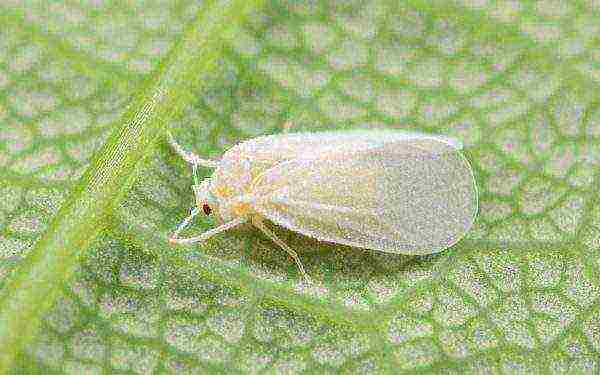 Whitefly: The butterfly is small, and there is a lot of harm from it
Whitefly: The butterfly is small, and there is a lot of harm from it
Harvesting and storage
Eggplant fruits ripen in Siberia not earlier than August. By the end of summer, in the warm season, up to 5–7 fruits can be harvested on each bush in the open field. Eggplants are harvested at the stage of technical maturity: the fruits must grow to the required size, acquire a color characteristic of the variety, and gain juicy pulp. The seeds at this time are white, soft, unripe. The crop is harvested weekly, cutting off the fruit with a pruner along with the stalk. Overripe eggplants are not edible.
Eggplants are stored for no more than three weeks. They must be stored with stalks, the best storage temperature is 1–2 ° C, and the relative air humidity is 85–90%. Since it is difficult to store them, they try to process the fruits in the very first days after collection.
In Siberia, summer is warm, but short, which is not enough for successful eggplant cultivation. Nevertheless, using various tricks, gardeners get good harvests of this delicious vegetable here. They do this both in greenhouses and outside them, but mainly early-ripening varieties and hybrids are planted and very carefully looked after.
Rate the article:
(0 votes, average: 0 out of 5)

